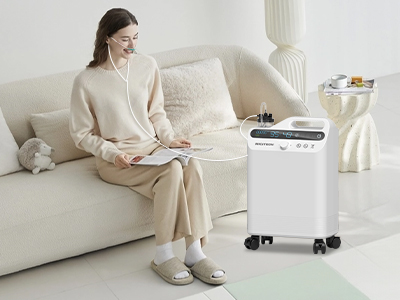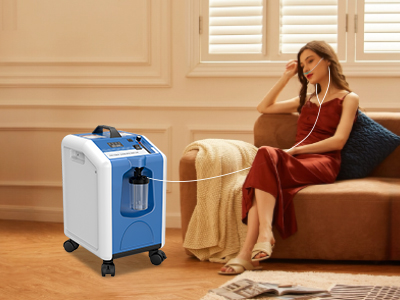13 Jun 2025
Designing a serene, safe, and functional oxygen therapy space at home is part science, part art, and a dash of interior design wizardry. Whether you’re managing a long-term respiratory condition or just giving your lungs a little boost after illness, the right setup can turn your home from “hospital-chic” to “health sanctuary.” And no, it doesn’t have to look like a sterile medical bunker. With a few strategic tweaks, you can transform any corner into a healing haven where oxygen flows and peace reigns.

Location and Inhalation
Choosing the right spot for your oxygen therapy space is the first—and possibly most crucial—decision you’ll make. You want somewhere calm and uncluttered, but also practical. Think of it as the real estate motto of respiratory care.
Quiet Corner, Please: Look for a low-traffic area where family members, pets, and rogue flying toys won’t be interrupting your zen.
Ventilation Nation: Ensure the space has good airflow without being drafty. Fresh air helps avoid oxygen build-up, which sounds cool in a sci-fi movie, but in real life? A little too explosive.
Proximity Matters: The area should be close enough to electrical outlets, away from heat sources, and ideally not wedged behind a bookcase or beneath a set of gymnastic rings. Accessibility is key.
Equipment Setup Without the Chaos
Now, let’s talk machinery. Oxygen concentrators, tanks, humidifiers—they’re the unsung heroes of the respiratory world. But without a bit of planning, they can look like a spaceship crash-landed in your living room.
Designate a Power Zone: Plug your oxygen concentrator into a grounded outlet with no extension cords or power strips. This isn't the time to play power roulette.
Contain the Cords: Use cord organizers or adhesive clips to guide tubing neatly along walls or under rugs (safely!). Nothing says “unexpected ER visit” like tripping over your own oxygen supply.
Surface Savvy: Place the equipment on a firm, stable surface—no wobbly side tables or grandma’s antique footstool. Machines vibrate, and vibrations plus unstable furniture equals disaster.
Ambiance: Healing With Style
Just because oxygen therapy is medical doesn’t mean the vibe has to be. Your space should whisper, “Relax, breathe easy,” not scream, “Waiting room at the DMV.”
Soft Lighting: Harsh lights are for interrogation rooms, not healing. Use warm LED lamps or a dimmable fixture to keep things cozy.
Soothing Scents (Without Flames): Use essential oil diffusers (electric only—no candles, remember we’re in an oxygen-rich environment) to add calming aromas like lavender or eucalyptus.
Decor, But Make It Safe: A few plants (the non-toxic, oxygen-boosting kind), some motivational wall art, or a fluffy pillow can go a long way—just keep clutter to a minimum and fire hazards to zero.
Tubing Management: The Great Untangle
Oxygen tubing has a sixth sense for entanglement. You start with a tidy coil, and the next thing you know, it’s braided itself into a Celtic knot and is now actively plotting against you.
Wall-Mounted Tube Tracks: These keep your tubing off the floor and along the wall, turning potential tripwires into architectural features.
Tubing Reels or Winders: Wind the excess tubing when not in use. Not only does it prevent tangling, but it also adds a satisfying “reel-it-in” moment to your daily routine.
Glow-in-the-Dark Tubing (Yes, It Exists): Prevents nighttime toe-stubbing and makes you feel like a low-key sci-fi hero.

Fire Safety: Because Breathing Shouldn’t Go Boom
Oxygen enriches life—and flames. Creating a safe space means being obsessively cautious about fire risks, like a hawk wearing a firefighter’s helmet.
No Flames, Ever: Candles, cigarettes, incense, matches—banish them. Even your favorite birthday sparkler gets the boot.
Smoke Detectors and Fire Extinguishers: Non-negotiable. Make sure they’re functional and nearby, but not collecting dust in a drawer labeled “emergency things.”
Alert the Household: Everyone in the home (yes, even the cat, if it listens) should know that oxygen therapy is in play and fire safety rules are in full force.
Comfort is the Secret Ingredient
Breathing support is great. But comfort? That’s the cherry on top. Your therapy space should make you want to stay and relax, not count the minutes until you're done.
Comfy Seating: Whether it’s a recliner, ergonomic chair, or your favorite beanbag throne, make sure your perch is supportive and adjustable.
Blankets and Throws: Breathable, washable, and snuggle-approved. Keep one nearby for a little luxury.
Hydration Station: A water bottle with a straw or a hot cup of tea within arm’s reach—hydration keeps airways happy and your soul soothed.
Smart Storage Solutions
You don’t want to rummage through drawers like you’re on a scavenger hunt every time you need a new nasal cannula. Organize like a pro.
Clear Bins with Labels: Store supplies like tubing, filters, and humidifier bottles in see-through bins with big, obvious labels. No guessing games.
Rolling Carts: Mobile therapy stations? Yes, please. These can hold your gear, wheels and all, and can roll from room to room like a VIP entourage.
Emergency Checklist Pinned Nearby: Keep a laminated sheet of what to do in case of power outage, fire, or if your concentrator starts sounding like it’s possessed. Peace of mind, neatly posted.
Keywords: oxygen therapy
Originally published 13 Jun 2025, updated 13 Jun 2025.